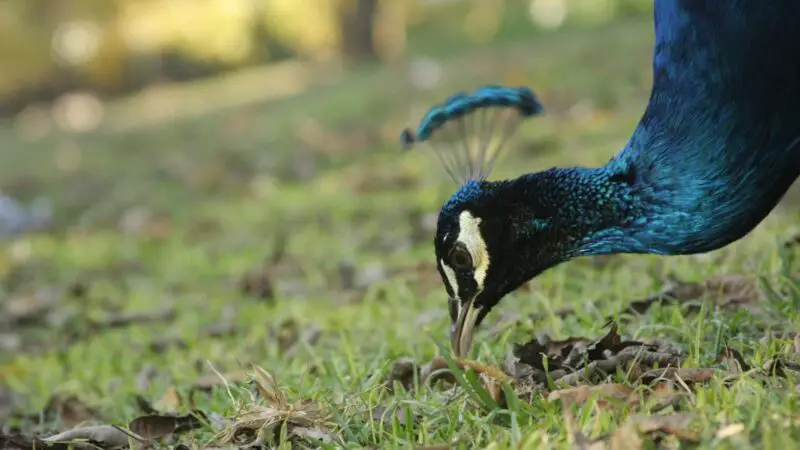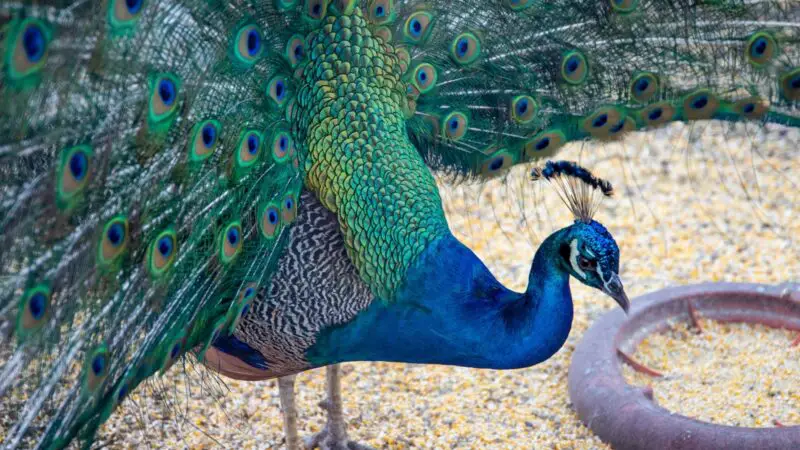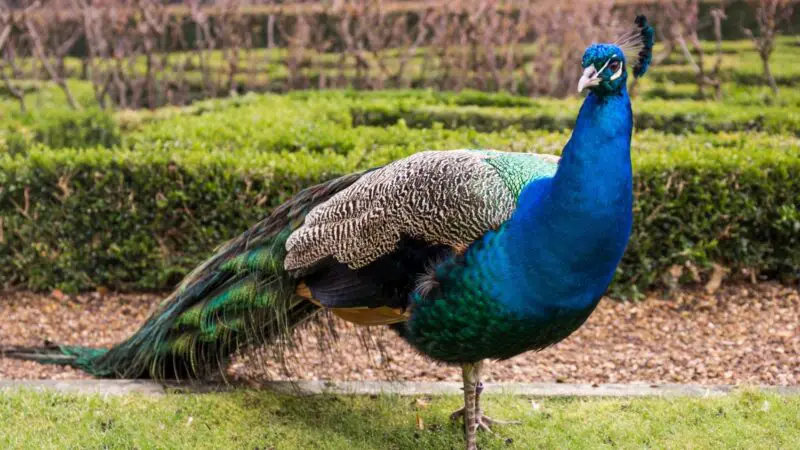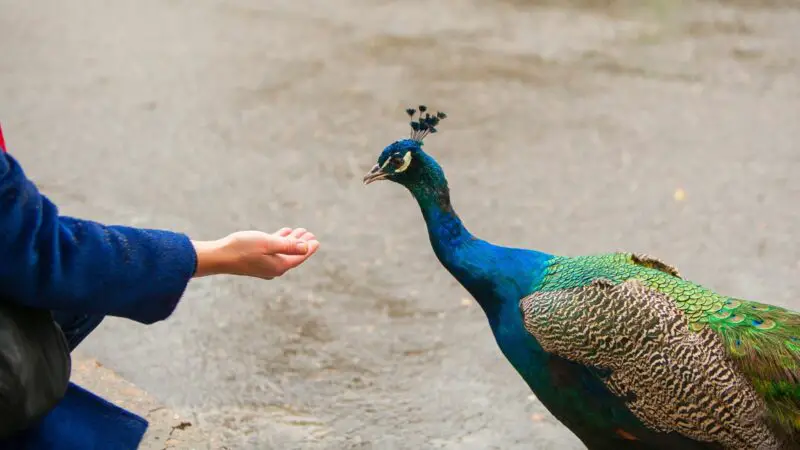Peacocks also referred to as peafowl, are exotic birds that are known for their colorful feathers. In suburban areas where they’re abundant, they’re viewed as a valuable part of neighborhoods and serve as beautiful attractions.
For them to achieve their vibrant plumage, their growth and development as peachicks should be ensured and properly monitored. This means that they have to be fed a well-balanced diet.
Peachicks should eat a variety of plant materials, fruits, vegetables, insects, and invertebrates, such as reptiles and amphibians, to ensure that they gain protein and essential nutrients. When feeding captive peachicks, grains and commercial feed can be integrated as a supplement in their diets.
To know more about what to feed peacocks and their peachicks, how they forage and eat their food, what kind of food they particularly like and dislike, and answers to interesting questions, read further this article!
What Is a Peacock’s Favorite Food?

Peacocks are omnivorous and like to eat insects, worms, snakes, lizards, and frogs. They’re also known to eat young cobra snakes, fruits, vegetables, mealworms, insect larvae, and plant materials such as flower buds, bamboo shoots, petals, grass, and grains.
How Do Peacocks Eat Their Food?
Peacocks usually forage plant material on the ground during the early morning and evening. However, they may also fly towards elevated areas to acquire more food, such as fruits and berries. They also roost and perch in these areas to look for potential prey.
For prey, peacocks will first use their excellent sense of hearing and vision to forage. Once they locate their prey, they will fly down to the unsuspecting animal and then ambush them, or they simply grab the animal using their beaks and then proceed to chew and swallow them.
What Kind of Food Do Peacocks Eat?

Fruits and Vegetables
For fruits, peacocks like to eat grapes, bananas, blackberries, apples, cantaloupes, raspberries, huckleberries, muscadines, tomatoes, watermelons, mangoes, pears, pineapple cores, and papayas.
Peacocks primarily eat green and leafy vegetables such as celery, lettuce, kale, cabbage, carrot tops, grass, and grass seeds, but they also eat grain products such as wheat, oats, rice, and corn. Other vegetables they consume are peas, beans, and herbs.
A bonus of eating fruits and vegetables is that there are also insects surrounding and feasting on them, which is beneficial for peacocks since they love to eat insects.
Processed Feed
Like other poultry, peacocks can also be fed with commercial feeds such as the following products:
- Manna Pro Gamebird Showbird Started Grower with 25% protein, yeast cultures, vitamins, and minerals. It comes in a crumble formula perfect for enhancing the growth and health of peacocks.
- ZINFOD Dried Black Soldier Fly Larvae provide peacocks with extra calcium, essential amino and fatty acids, and minerals. This product is free of additives and preservatives and is considered a sustainable source of protein.
- Wagner's Farmer's Delight Wild Bird Food is an all-purpose, high-quality mix of cherry-flavored cracked corn, millet, sunflower, and milo that peacocks will surely love. Be wary of squirrels as they might also get attracted to this feed.
Take note that these should be used as supplementary feeds to their main diets, which should be composed of plants and insects.
Bugs and Little Invertebrates
Peacocks enjoy and primarily consume almost any insect, such as termites, crickets, ants, grubs, and locusts. They also feed on invertebrates such as lizards, snakes, scorpions, wax worms, earthworms, mice, millipedes, and centipedes.
Mealworms
Mealworms are a source of high protein for many birds, including peacocks. They’re larvae of mealworm beetles and are fed either live or dried.
Here are some mealworm products you can consider purchasing when you don’t have any mealworms on hand:
- Kaytee Mealworm Food Pouch contains high-quality, oven-dried mealworms that can be fed alone or blended with plant seeds.
- PICKY NEB Natural Dried Mealworms are non-GMO and free of preservatives, dust, and additives. It also comes in resealable bags for easy storage.
- Downtown Pet Supply Dried Mealworms are rich in B vitamins, protein, and fiber that boost the health and immune systems of peacocks.
Other Insect Larvae
Aside from mealworms, they also enjoy eating housefly larvae, black soldier fly larvae, and common fly larvae.
What Food Do Peacocks Dislike?
Plants that peafowl dislikes and will actively avoid eating include azaleas, bougainvilleas, cacti, camellias, ferns, hibiscus, hardy lavenders, iris, ivy, marigolds, mints, periwinkles, peonies, shasta daisies, and snapdragons. It is either because of their toxicity or simply because they’re unpalatable to them.
Can Peacocks Eat Chicken Food?

Peacocks can eat chicken food. However, it is not recommended as it doesn’t contain enough protein and other essential nutrients. Usually, they’re only used as supplementary diets to their existing meals, which consist primarily of plants and insects.
How Do Peacocks Find Their Food?
They find their food by foraging early in the morning or evening. Peacocks simply use their senses and look for food either on the ground or fly to elevated areas for food that are harder to reach and to find prey.
Can You Feed Wild Peacocks?

Peacocks also roam residential areas in search of more food sources. While it’s legal to feed them, it’s discouraged since they can forage food on their own in their natural habitats in the wild. Foraging also helps build their biological survival skills.
As with other wild animals, when you start feeding peacocks, they may become a neighborhood nuisance. It’s alright to feed with plants, seeds, and insects but do so in small amounts only and not by hand—leave them in bird feeders, then immediately dispose of leftovers to avoid overfeeding.
Are Peachicks Strong Enough to Get Their Own Food?
Once peachicks hatch from their eggs, they are well-developed enough to forage on their own and feed themselves from birth. They are even able to walk and leave their nests for a few hours and follow their mothers.
At two weeks of age, they can fly at elevated areas such as trees and shrubberies from which they can also forage.
Peafowl that is raised on farms will thrive on a balanced ration, which consists of 28% protein for 4 months. After that period, they are fed with 14% protein until they reach 1 year old. These grower rations can also be used for adults.
They can also learn to eat grain on their own, but it must be supplemented with chopped green or leafy vegetables and insects to ensure that they achieve and maintain their well-balanced diets.
What Are the Best Treats for Peachicks?
Fresh berries and fruits are a recommended treat for feeding peachicks. Grains, such as wheat and oats, as well as plant seeds, can also be fed to peachicks as they are excellent sources of protein and other essential nutrients needed for the growth and development of peachicks.
Can Peacocks Eat Bread?
Peacocks can eat bread. However, it is not recommended as they provide no nutritional value to peacocks and may even cause gastrointestinal and nutritional deficiencies when fed in large amounts. Hence, it’s better to feed them with fruits, vegetables, and grains.
Why Do Peacocks Need a Lot of Proteins?
Protein breaks down into glucogenic and ketogenic amino acids that can be used for supplying the energy of peacocks. It boosts their health and overall productivity. However, too much protein can lead to liver and kidney diseases, so it’s best to feed them protein in moderation.
What Is the Best Source of Food for Peachicks?
Fruits, vegetables, plant material (leaves, stems, and flower buds), grains, and insects are excellent and essential sources of food for peachicks. When feeding captive peafowl, they can be combined with pellets, millet, cooked rice, and corn.
Can You Change the Diet of Peachicks?
You cannot change the diet of peachicks. They must always have a well-balanced, nutritional meal composed of their usual diet, which is fruits, green vegetables, insects, invertebrates, and other plant materials to ensure their proper growth.
Peacocks are omnivores that eat various plants, fruits, vegetables, invertebrates, and insect larvae. Peachicks can forage and feed themselves as soon as they emerge from their eggs. Their diets are protein-rich because it provides them with the energy they need.
Wild peacocks should be fed with fruits, vegetables, and seeds. Otherwise, they should be left alone, or else they would have nutritional deficiencies if given human food.
